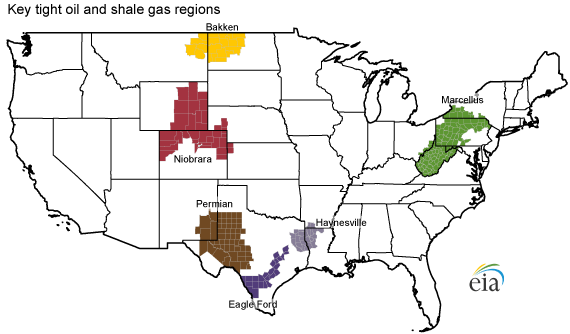| Spin Doctor: A person (such as a "Talking Head") who tries to control the way something is described to influence public opinion in a way that helps their side and hurts (often demonizing) differing views. "Spinning" always contains some elements of truth to enhance credibility, but conveniently overlooks/dismisses any facts not helpful in forming the desired public perception. |
Current Status of U.S. Foreign Oil Dependency: Over the past 7 years, the amount of oil supplied from foreign sources has decreased from an all-time record peak of 60% in 2005 to currently ~40%. While lower oil consumption (resulting from economic recession, greater auto efficiency) has played a part, this amazing (and hopefully sustainable) achievement has been primarily the result of technology advancements in oil extraction.
| Per the U.S. Energy Information Agency's (EIA) long-term forecast, foreign oil use is expected to decline even further (with an estimated 32% from oil imports by 2040). Through the extensive use of fracking and horizontal drilling, almost all of this domestic growth in oil and natural gas production is occurring in six U.S. regions: | & Consumption:  |

What Spin Doctors Don't Tell Us On U.S. Foreign Oil Dependency: In this renaissance of U.S. oil production, one often hears the sound-bites of "Energy Independence", "Freedom from Mid-Eastern Oil", "Canada is now America's #1 Oil Importer". The problem with these now generally held public perceptions is that they don't exactly tell the full story.
While it is correct that Canada is now the "single country" largest exporter of oil to the U.S., the Mid-east dominated oil cartel of OPEC (which includes a very oil-hostile Venezuela) remains America's largest supplier of foreign oil.

Total Oil Consumed in Other Nations


Use of Cherry-Picking Ideological Arguments: Perhaps the most hypocritical example of selective cherry-picking by "Spin Doctors" is the commonly used "sound-bite": "Free Markets should determine energy winners and losers, not big-government".
| The following graph (using EIA data) breaks out the individual components of current pump gas prices -- where U.S. consumers currently "have no choice" but to pay 37¢ per gallon to OPEC for crude oil costs.1 From an ideological argument perspective, this is the equivalent of a mandate that 16% of all gasoline be blended with OPEC oil. 2 |  |
| 1 69% of the current pump price of gasoline is crude oil costs ($2.30 per gallon). 40% of all crude oil is from foreign sources (92¢). 40% of foreign oil is from OPEC (37¢). 2 40% of all oil consumed is from foreign sources and 40% of foreign oil is from OPEC (40% times 40% equals 16%.) |
OPEC is anything but "free market trade" -- a cartel that manipulates markets, restricts output and fixes prices that's had a devastating effect on the U.S. economy. But OPEC's reach is beyond just its Middle-East members, where Venezuela has nationalized and continues to seize U.S. Oil Companies' assets.
What The Spin Doctors Don't Tell Us On Economics: The message of "Drill, Baby, Drill" has mass public perception appeal of basic supply/demand economics that even a caveman can understand. It's just common sense that if U.S. oil production increases (by removing "big-government" barriers) that gasoline prices at the pump will decrease -- Right? Well, not exactly.
An inconvenient fact is that extracting oil using fracking and horizontal drilling technology has dramatically higher costs than in typical Middle East oilfields. According to Oil Analysts, the average cost of new oil production from U.S. tight oil and shale gas regions is ~$70 a barrel, with marginal costs (the last barrels produced) as high as $114 a barrel in 2012.1, 2, 3
| Conversely, for conventional oil output in the Middle East, average production costs are just over $20 a barrel , with marginal costs at ~$30 per barrel. |

While there are numerous economic benefits in developing domestic energy resources (e.g., job creation, economic development, reducing the massive U.S. Trade Deficit) -- expectations of significantly lowering the "current" price of crude oil isn't one of them. Simply stated, because of the high extraction costs of advanced technologies, increased U.S. oil production is totally dependent on maintaining high oil market prices.
In order to achieve claims made by "Spin Doctors" for a return to $2 gasoline by increasing U.S. oil production would require a precipitous price drop to ~$40 a barrel (bbl) -- a market price significantly below either the average (~$70/bbl) or marginal (~$110/bbl) costs to extract oil using fracking/horizontal and deep-sea drilling.
We Need to have a "Real" Energy Policy Debate: In order to have a meaningful dialog everyone needs to pause, take a deep breath, and move away from the extreme polarization that partisan "Spin Doctors" create. Energy policy shouldn't be limited to "Red State vs. Blue State" tunnel vision on any one specific "hot button" issue (ranging from Conservatives mistrust of big government to Environmentalists' adamancy on Climate Change).
It's about addressing a myriad of problems and trying to solve them -- compromising and finding common interests in a bigger picture rather than focusing on things that divide us.

Additional News Stories:
In U.S. Public Opinion Polls, Saudi Arabia is viewed very unfavorably.
Record Growth in U.S. Oil Production.
Global Oil Prices and Energy Security
Fact Check on Keystone Pipeline Claims
No comments:
Post a Comment